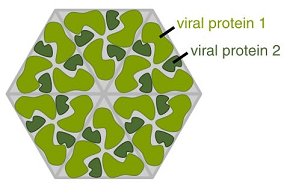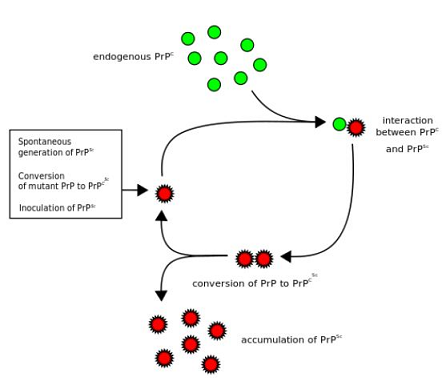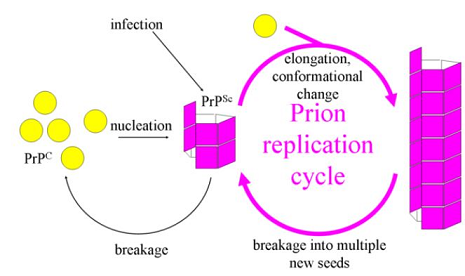|
|
|
Medical Pharmacology Chapter 36: Antiviral Drugs
|
A virus is defined by a nucleic acid which is surrounded by at least one protein.1
 |
|
An outer-membrane envelope may also be present and viruses are classified as a parasite since their replication is dependent on host cells.
Viral nucleic acids are insufficient encoding for the numerous enzyme proteins required for lipid, carbohydrate, or protein metabolism.
Viral nucleic acids are principally concerned with replicating and packaging viral nucleic acids while residing inside host cells.1
With respect to the range of infectious agents, viruses are smallest, with diameters extending from about 20 nm to 300 nm in diameter.
If one defines the infectious unit as including the nucleic acid, its protein shell and lipid containing membrane, if present, the infectious unit defines the virion.4
Terms similar to viruses include: virusoids, viroids, and prions.1
Virusoids are described as nucleic acids which depend on helper viruses for nucleic acid packaging into virus-like particles.1
Dependency on helper viruses classifies virusoids as "satellites."
Also, virusoids may be described as sub-viral particles.
Viroids ("virus-like") are "small, circular plant pathogens."1,5,6
Lastly, prions are infectious, abnormal protein molecules which reproduce by altering the structure of their normal cellular protein counterparts.1
 |
|
 |
|
Prions have been suggested as possibly causative in certain neurodegenerative diseases including Creutzfeldt-Jakob disease and "mad cow disease", also known as human bovine spongiform encephalopathy.1
 |
|
The viral genome may consist of several nucleic acid structural forms.1
![]() Some viruses are based on single-strand or double-strand DNA
(1); whereas, others depend on single-strand sense RNA or positive-sense RNA
(2).
Some viruses are based on single-strand or double-strand DNA
(1); whereas, others depend on single-strand sense RNA or positive-sense RNA
(2).
Other possibilities include a single-strand are segmented anti-sense (negative strand) RNA (3) or a double-strand segmented RNA (4).1
A sense strand allows comparison of the RNA base sequence to that of mRNA.1,11
With positive-sense RNA, the RNA base sequence is the same as mRNA and may serve directly as a protein synthesis template.
In negative-sense the viral RNA exhibits a base sequence complementary to that of mRNA.
A negative strand RNA virus is also referred to as an anti-sense-strand RNA virus.1
Viruses encode nucleoproteins which are found at the viral particle core and these nucleoproteins associated with viral nucleic acids.
The combination of nucleoproteins and viral nucleic acids is enclosed in a protein capsid.
Capsids consist of multimeric identical capsomeres which themselves are composed of one or just a few proteins.
|
|
|
|
|
Capsid structures are described as having icosahedral or helical symmetry.
Icosahedral structures, although resembling spheres, exhibit 2-fold, 3-and 5-fold symmetry axes.
|
|
|
|
|
|
Viral structural characteristics are important both for classification and describing structural and functional properties of viral proteins.4
Specific functional features that described virus families are themselves specified by virion function such as "morphogenesis and release from infected cells", transmission two new viral hosts and then attachment, penetration, and uncoating in those newly infected cells.4
More about viral particle symmetry4:
Several techniques have been used to obtain basic information concerning viral structure at small dimensions.
These techniques include x-ray diffraction methods, cryoelectron microscopy and electron microscopy.
In electron microscopy surface structure is typically enhanced through the use of heavy metal stains.
Sample preparation typical for electron microscopy may result in alterations of particle morphology.
Rapidly frozen viruses in combination with cryoelectron microscopy enhances fine structural details.4
|
|
|
A higher level of resolution is provided by x-ray crystallographic techniques; however, the application of this method is somewhat limited, since the specimen to be analyzed must be crystalline thus limiting consideration to small, nonenveloped viruses..4
An example of a common cold virus has nonetheless had its structure resolved by x-ray crystallographic methods.16
The common cold virus, rhinovirus 14 serves as an example.
|
|
|
|
|
|
As noted above, one type of viral symmetry is cubic symmetry and with animal viruses the pattern is icosahedral.
The icosahedron has 20 faces, each being an equilateral triangle and exhibits twofold axes of rotational symmetry.
The icosahedron is shown in the figure below.
The surface of an icosahedron is described by 60 identical subunits.4
Accordingly, 60 structural units are required to create the viral shell that encapsulates its genome.
Despite the virus expressing icosahedral symmetry, viral shape in terms of physical appearance is spherical.4
|
|
|
Parvoviruses represent another example of virions with icosahedral symmetry.28
This virus contain about 5 kb of single-stranded DNA.
The parvovirus capsid protein is described by a "jelly-roll β barrel."28
A β-barrel is described as a large β-sheet which twists and coils forming a close structure in which the first strand binds to the last.
|
|
|
Poliovirus is another example of a virus exhibiting icosahedral symmetry.
The viral genome codes for three structural proteins.
The three poliovirus capsid proteins exhibit the jelly-roll β-barrel structure described earlier.28
|
|
|
An isometric (icosahedral) virus particle contains a condensed viral nucleic acid structure.
The organization required for the condensed viral nucleic acid structure is facilitated by viral-encoded core proteins or for some viruses cellular histones.
Viral cubic structural symmetry can be found in some examples of both DNA and RNA viruses.4
Helical Symmetry
Another type of symmetry is helical symmetry in which protein subunits associate with viral nucleic acid in a helical manner.
This process leads to a filamentous nucleic acid-protein assembly (its nucleocapsid) which is then localized in the envelope.
Animal viruses exhibiting helical symmetry are typically RNA viruses (rhabdoviruses represent an exception) and form "ball shape" nucleocapsid structures.4
|
|
Rhabdoviruses represent an example of an animal virus exhibiting helical symmetry.
|
|
Vesicular stomatitis is caused by a Rhabdovirus, specifically vesicular virus from the Rhabdoviridae family.
|
|
|
This Web-based pharmacology and disease-based integrated teaching site is based on reference materials, that are believed reliable and consistent with standards accepted at the time of development. Possibility of human error and on-going research and development in medical sciences do not allow assurance that the information contained herein is in every respect accurate or complete. Users should confirm the information contained herein with other sources. This site should only be considered as a teaching aid for undergraduate and graduate biomedical education and is intended only as a teaching site. Information contained here should not be used for patient management and should not be used as a substitute for consultation with practicing medical professionals. Users of this website should check the product information sheet included in the package of any drug they plan to administer to be certain that the information contained in this site is accurate and that changes have not been made in the recommended dose or in the contraindications for administration. Advertisements that appear on this site are not reviewed for content accuracy and it is the responsibility of users of this website to make individual assessments concerning this information. Medical or other information thus obtained should not be used as a substitute for consultation with practicing medical or scientific or other professionals. |